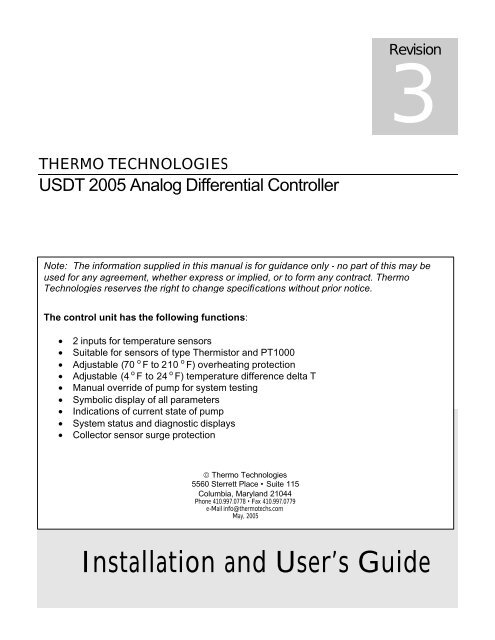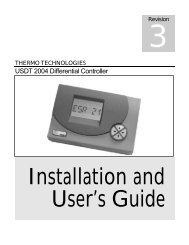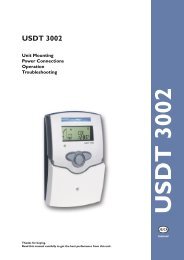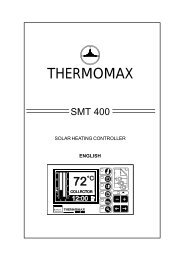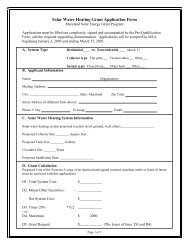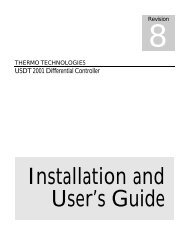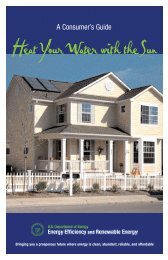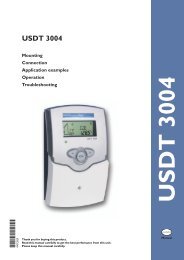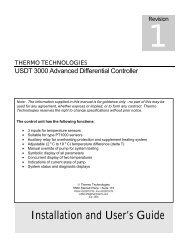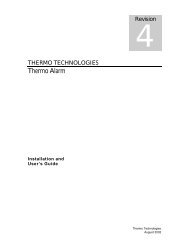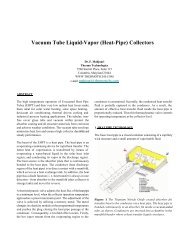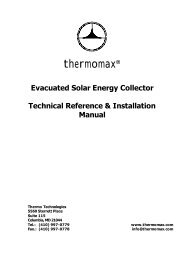Analog Differential Controller - Thermomax Technologies
Analog Differential Controller - Thermomax Technologies
Analog Differential Controller - Thermomax Technologies
- No tags were found...
You also want an ePaper? Increase the reach of your titles
YUMPU automatically turns print PDFs into web optimized ePapers that Google loves.
Revision3THERMO TECHNOLOGIESUSDT 2005 <strong>Analog</strong> <strong>Differential</strong> <strong>Controller</strong>Note: The information supplied in this manual is for guidance only - no part of this may beused for any agreement, whether express or implied, or to form any contract. Thermo<strong>Technologies</strong> reserves the right to change specifications without prior notice.The control unit has the following functions:• 2 inputs for temperature sensors• Suitable for sensors of type Thermistor and PT1000• Adjustable (70 o F to 210 o F) overheating protection• Adjustable (4 o F to 24 o F) temperature difference delta T• Manual override of pump for system testing• Symbolic display of all parameters• Indications of current state of pump• System status and diagnostic displays• Collector sensor surge protection© Thermo <strong>Technologies</strong>5560 Sterrett Place • Suite 115Columbia, Maryland 21044Phone 410.997.0778 • Fax 410.997.0779e-Mail info@thermotechs.comMay, 2005Installation and User’s Guide
IntroductionTsystem.he USDT 2005 unit is an analog temperature differential controller. It can be used in awide range of applications. At the factory, it is set to control a simple solar water heatingSolar System Control (S) ModeIn this program mode, it ensures that the collected energy from the sun is transferred efficiently,and harnessed under optimum conditions. It monitors the collector temperature (T KS ) and thereturn temperature (T BS , bottom of the storage tank). Thesolar loop circulation pump runs while the collector S1temperature exceeds the return temperature by anadjustable temperature difference ?T. To avoidoverheating, the circulation pump stops if the returntemperature (T BS ) reaches the adjustable high limit (T MAX )temperature. The temperature hysteresis (a lagging in theset-point) may over-ride ?T to avoid pump cycling.The pump A1 runs only when the temperature at thecollector sensor location S1 is higher than the returntemperature at location S2 by at least ?T. The pump stopsif ?T is less than the preset value or, the if the temperatureat location S2 (storage tank) has reached the T MAXA1S2A1 (ON) only when S1 > (S2 + diff)& S2 < maxBoiler Control (L) ModeThe User can switch USDT 2005 to operate a boiler circulator. In boiler mode (L), the pump runsonly when boiler temperature at S1 locationis higher than the minimum set point dialerand the ?T condition is satisfied.A1 (ON) only when S1 > max &S1 > (S2 + diff)Note: The maximum temperature dialer(max) serves as the minimum startingtemperature, T MIN in the boiler mode. Usermust change the switch position on the backof the circuit board to use the USDT 2005 as a boiler controller. Details will follow.MAX set point protects the solar system from overheating. It turns off the circulator if the boilercontribution to the storage tank is not satisfied.S1A1S21
Selection of Operation ModeIf you are using USDT 2005 for a solar system, you don’t need to change anything. To use theunit as a boiler controller, change the miniature switch level to the desired position as shownbelow. The switch is located on the right side of the circuit board:L+PL+KS+PS+KANS 21Change the switch position only when the unit is not energized. It is possible to damagethe control unit if the mode change is performed under voltage.Switch Positions:• S+K Solar systems with KTY (2000 ohm) sensors• S+P Solar systems with PT 1000 (1000 ohm) sensors• L+K Boiler control with KTY (2000 ohm) sensors• L+P Boiler control with PT 1000 (1000 ohm) sensorsThe impedance characteristics of sensors temperature dependencies are represented in thefollowing table:T 0 10 20 25 30 40 50 60 70 80 90 100°CR(KTY) 1630 1772 1922 2000 2080 2245 2417 2597 2785 2980 3182 3392 WR(PT) 1000 1039 1078 1097 1117 1155 1194 1232 1271 1309 1347 1385 WSPECIFICATIONSupply VoltageFusePhantom LoadHysteresisDelta TOverheating Range120 V AC3.15 Amax. 2 W6 degrees4 – 24 o F100 – 200 o F2
INSTALLATIONNote: This installation procedure is for guidance only, and the installer should verify itssuitability. Make sure that the solar/boiler system is physically installed, manually tested, and isready for controlled operation.T he following safety precautions are strongly recommended:1. Before attempting to install and operate the unit read this instruction manual carefully.2. Only suitably qualified personnel should carry out installation and any maintenance required.3. It is recommended that the unit be connected to the power supply via a suitably 6 ampsisolating switch.4. WARNING: When the unit is connected to the 115-volt power supply and the cover isopened, high voltage circuits will be exposed. Therefore, when installing the unit ensureall required connections are made and the cover is attached to the controller box beforeturning the power on. Ensure that all the connections are secure. If any maintenance work isrequired ensure that the unit is isolated from the power supply before removing the cover.Never leave the unit unattended if the cover has been removed and the power supplyis connected.5. Do not exceed unit ratings of 2.15 amps (1/6 HP or 245 Watts pump).6. It is advisable to route power cables away from sensor cables.Sensor installation: Temperature sensors may be installed in fluid lines by mounting in atee or strapping it to the piping directly. For the system to function correctly, it is veryimportant that the sensors are located and installed properly. Make absolutely sure that they arepushed completely into the optional sensor pockets (Thermowell is not supplied). Sensors mustbe well insulated in order to prevent them from being infl uenced by the ambient temperature.When used outdoors, no water should be allowed to get into the immersion sleeves (lastingimpedance change). Generally, sensors should not be exposed to moisture (e.g. condensation)as this can diffuse through the cast resin and damage the sensor. Heating at approx. 195 °F forone hour may possibly save the sensor.When sensors are used in open loops or swimming pools, make absolutely sure that immersionsleeves (sensor pockets) are corrosion-resistant.3
• Collector sensor (red cable with protective terminal box): Insert the sensor jacket into athermowell (sensor pocket), or strap it to the collector outlet pipe (flat plat collectors) that projectsfrom the collector housing. The best practice is to install a suitable sensor pocket into a T-pieceon the collector return outlet, to house the collector sensor. Protect sensor cable from UV andmoisture.• Storage tank installation (white cable): The sensor required for the solar loop is installedin the lower part of the storage tank. If there is no provision for a tank sensor, it is advisable topush the sensor beneath the insulation – keeping it close to the inner tank wall at the desired tanklocation.• Pool sensor installation: Place a heat conductive T-piece on the suction line directly at thepool outlet and screw in the sensor with an immersion sleeve (check corrosion resistance of thematerial used). Another possibility would be to attach the sensor at the same place with clips oradhesive tape, using appropriate thermal insulation against environmental influences.• Sensor cable extension: Sensor cables (22/4 AWG telephone cable) can be extended upto 150 ft. A connection between the sensor and extension can be established as follows:Cut supplied heat shrinkable tubing to desired length (about ½ ”). Slide tubing over one end ofwire to be sliced after removing enough outer insulation to accept the tubing. Then splice wireand slide tubing over the splice. Heat gently all around until tubing shrinks tight.Slide larger tubing (about ¾ “) over the entire completed splice. Heat gently all around until tubingshrinks tight. This connection can then be drawn gently into the pipe work. You need only twowires for sensor cable; the other two wires are spare wires. Do not overheat tubing! Remove heatas soon as tubing shrinks tight, as material will continue to shrink. With flame source, use evenback and forth motion all around tubing. A heat gun may be used, if available. Let tubing cool formaximum strength.C ontroller unit installation: For viewing comfort, the controller unit should bepositioned at eye level. It is always good practice to keep electronic equipment awayfrom cold, and heat, as extremes of temperature may reduce the lifetime of the device. It is alsogood practice to keep electronic equipment away from heavy electrical loads, switches orcontactors as these may cause electrical and electromagnetic interference when switched on oroff.Base of the unit to be mounted at the eye-level and wired as shown above4
Undo the four screws at the corners of the housing. The control electronics are mounted on theenclosure cover. Using proper fixing, the controller enclosure can be screwed to the wall withcable entry grommets downwards.Caution: <strong>Controller</strong> wiring should only be done when the unit is not energized. It is possible todamage the control unit if it is assembled under voltage. Miniaturized terminal blocks are used formaking wiring connections. The wire is held in place within the terminal with a screw that providesexcellent contact without damage to the wire.Cable Connection: A small blade screwdriver may be used to fasten miniaturized terminalblock screws while the corresponding wire is inserted.Use up to an 18 AWG stranded wire to connect the sensor cables to the unit. The KS terminalshould be connected to the collector sensor (higher temperature); the BS terminal is designatedfor the return sensor (lower temperature).Power Connections: A small blade screwdriver may be used to fasten miniaturizedterminal block screws while the corresponding wire is inserted.NOTE 1: Always disconnect the controller from power supply before opening the housing.NOTE 2: The controller should be properly grounded. Flexible wires, 18/3 AWG(gauge/conductor), simplify connection to the terminals. The power terminal block willaccommodate wire sizes to 14 AWG. All other connections should be secured and adequatelytightened, as loose power connections will over-heat, and may cause fire.NOTE 3: It is important that the specified output loads (245 Watts) are not exceeded. Wherethese loads expect to exceed, external relays must be used. Always keep power cables awayfrom sensor cables and other low voltage signal cables.NOTE 4: To protect against lightning damage, the system must be grounded according to localregulations. Sensor failures due to the weather or electrostatic are mostly due to poor grounding.T ROUBLESHOOTINGProblem: Nothing happens when unit is powered-up.Cause/Remedy: The fuse could be blown – check and replace if necessary. If the fuse blowsagain, then the pump draws more current than the unit is design to supply. Use an auxiliary relayor contact your product supplier.Problem: One or more LED’s is fluctuating.Cause/Remedy: This indicates a system alarm warning, which may be caused by a sensor fault:• Lower Collector LED blinks è Collector sensor cable is short circuited• Lower Storage Tank (70 o F) LED blinks è Return sensor cable is short circuited• Upper Collector LED blinks è Collector sensor cable is open• Upper Storage Tank (200 o F) LED blinks è Return sensor cable is open5


